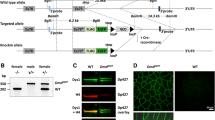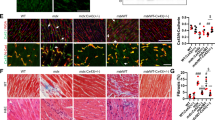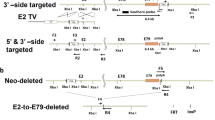Abstract
Inactivation of one X chromosome (X inactivation) in female mammals results in dosage compensation of X-chromosomally encoded genes between sexes. In the embryo proper of most mammals X inactivation is thought to occur at random with respect to the parental origin of the X chromosome. We determined on the cellular level the expression of the X-chromosomally encoded protein dystrophin in skeletal and cardiac muscle of female mice heterozygous for a null mutation of the dystrophin gene (mdx/+). In all muscles investigated (cardiac, anterior venter of digastric muscle, biceps brachii and tibialis anterior muscle) we found a mosaic expression of dystrophin-expressing versus non-expressing cells and determined their proportion with respect to the parental origin of the X chromosome. In all groups of mdx/+ mice the level and pattern of dystrophin expression were found to be dependent on the parental origin of the mdx mutation. Additionally, the extent of dystrophin expression was clearly dependent on the mouse strains (C57BL/10 and BALB/c) used to produce heterozygous mdx/+ mice. Variable differences and patterns of dystrophin expression in skeletal versus cardiac muscle were found that were strictly dependent on the parental source of the mdx mutation and the strain used to breed mdx/+ mice. Moreover, dystrophin expression was found to be different between the right side and the left side of the body in individual muscles, and this difference was clearly dependent on the parental origin of the X chromosome. Our data provide evidence that in the mouse embryo proper there is a non-random distribution of cells showing inactivation of the paternal versus the maternal X chromosome in skeletal and cardiac muscle, indicating a non-random X-inactivation. Besides gametic imprinting, strain-, tissue and position-dependent factors also appear to bias X inactivation.
Similar content being viewed by others
Author information
Authors and Affiliations
Additional information
Accepted: 19 August 1996
Rights and permissions
About this article
Cite this article
Bittner, R., Popoff, I., Shorny, S. et al. Dystrophin expression in heterozygous mdxl+ mice indicates imprinting of X chromosome inactivation by parent-of-origin-, tissue-, strain- and position-dependent factors. Anat Embryol 195, 175–182 (1997). https://doi.org/10.1007/s004290050036
Issue Date:
DOI: https://doi.org/10.1007/s004290050036




